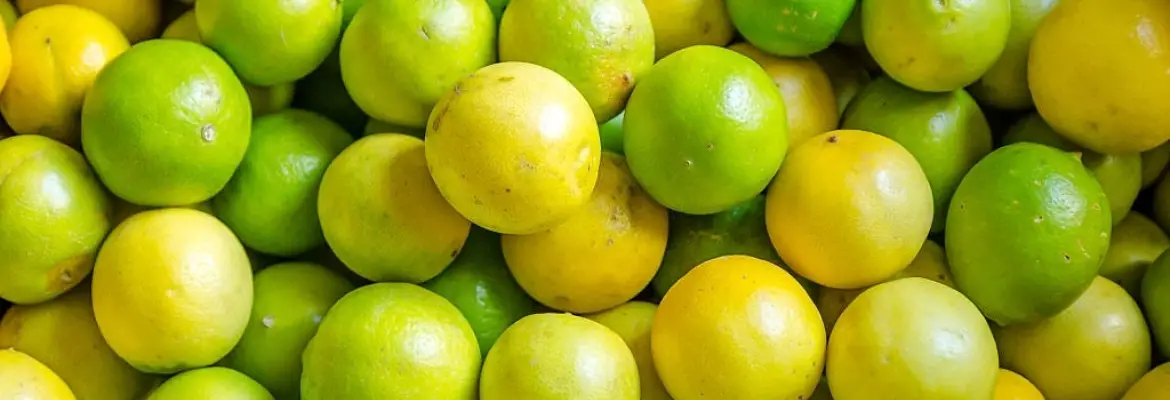Lemon is one of the most common types of citrus grown commercially and in home gardens throughout the world, widely renowned for its acidic, sour taste and sweet, aromatic scent.
Lemons are small to medium sized fruits with pointed, curved ends and an ovate to oblong shape. Lemon peels are generally pale to bright yellow in color and contain numerous small oil glands, creating a textured and glossy surface with fine pitting.
Lemons encase 8 to 11 segments of soft, seeded or seedless tender yellowish-flesh made of translucent juicy sacs. Lemons are recognized for their complex, bright, and acidic flavors.
Average size of a lemon can be 1-2 inches (2.5 – 5 cm) in diameter. Average length of a lemon can be 2-3 inches (5-7.5 cm). Average weight of a lemon can range from 50 – 80 grams (1.7 – 2.8 ounces or 0.11 – 0.17 pounds).

Scientific name of Lemon
Citrus Limon
Other names of Lemon
- Limão
- Limón
- Citron
- Nimboo
Calories by source in Lemon
- Calories by carbohydrate in Lemon = 83%
- Calories by fat in Lemon = 6%
- Calories by protein in Lemon = 11%
Fats and Fatty Acid profile of Lemon
- Polyunsaturated fat (PUFA) in Lemon = 64%
- Saturated fat (SFA) in Lemon = 28%
- Monounsaturated fat (MUFA) in Lemon = 8%
Nutrition facts of Lemon
*Serving size = 100 grams = 3.55 Ounces = 1/2 cup
*DV= % Daily Value (%DV indicates how much nutrients contribute to a person’s daily diet from a serving of a food. DV assists you in determining whether or not a serving of food is high or low in a particular nutrient.)
| Nutrient | Amount | Unit | DV |
|---|---|---|---|
| Calories | 29 | KCAL | |
| Fat | 0.3 | GRAM | 0% |
| Protein | 1.1 | GRAM | 2% |
| Carbohydrate | 9.32 | GRAM | 3% |
Detailed vitamin profile of Lemon, vitamin A, vitamin B12, vitamin B6, vitamin C, vitamin D, Folate, Niacin, Thiamin, and Riboflavin is shown in the chart.
Detailed mineral profile of Lemon, Sodium(Na), Calcium(Ca), Copper(Cu), Iron(Fe), Magnesium(Mg), Selenium(Se), Phosphorus(P), Potassium(K) and Zinc(Zn) is shown the chart.
Check freshness in Lemon
- Choose lemons with bright yellow thick skin
- Fresh lemon is dense and feels heavy for its size
- Select firm lemons and avoid mushy and soft lemons
- Avoid lemons with white spots. These white spots mostly have a tendency of developing molds
- Avoid lemons with brown wet dents and pits
- In case of yellow lemon, avoid lemons with green spots or greenish undertone
- Old lemons will have dull, dried up and thin skin
- Fresh lemons will have citrus acidic smell
- Unripe lemons are green in color (Remember lime is different from lemon)
Availability of Lemon
- Generally available round the year
How to store Lemon
- Mature lemons can be stored at room temperature for 4-5 days
- Mature lemons can be stored in refrigerator for 3-4 weeks
- Ripe lemons can be stored in freezer for months
- Cut lemons can last for 3-4 days in the fridge (Its skin will start browning fast but it is still consumable in this storage period)
- Tightly wrapping the cut lemons in a plastic wrap might increase their storage life in fridge
- Avoid storing cut lemons at room temperature
- Lemons go bad in warmer climate much faster when compared to cooler climate
- Before storing the lemons in the freezer, its recommended to wash the lemons and pat drying them
- Cut lemons can be frozen on a tray and after freezing can be stored in air tight container of bags in the freezer
Complete nutrition facts of Lemon
Click on the link HERE to download high quality, high resolution and print ready PDF version of the Lemon nutrition chart/infographic.


